

I have a second page of pictures of Copernicus showing the crater at different magnifications on the same night.
Move your mouse over the picture to see the names of the various features.
Copernicus is a very young crater at less than 1,000 million years, and is a typical impact crater of this size. It is 95 Km in diameter and its walls rise to 3,760 metres. It has three central mountains, the highest 1,200 metres high. The northern part of the floor is significantly smoother than the southern part.
Click on the first picture to see a larger picture of the area and a brief description of impact craters.
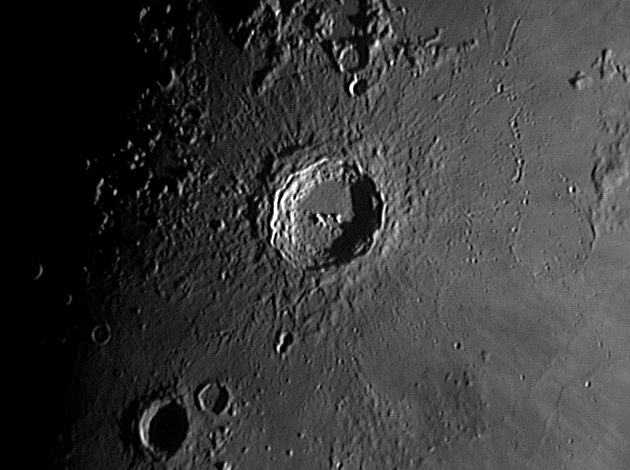
|
This is a general picture of Copernicus and its surroundings taken at lunar day 9.8. The mountains at the top of the picture are the Carpathians on the southern edge of Mare Imbium. South is Mare Insularum which surrounds Reinhold. The angle of the Sun is fairly low and brings out the detail surrounding Copernicus including the raised platform on which the crater sits. Click on the picture to see a mosaic, taken the same night, of this with one covering Eritosthenes. The scale markers are roughly 100 Km north and east. Date and Time: 10th December 2005 20:18 UT Camera: ToUcam 740K Telescope: LX200 at prime focus Capture: K3CCDTools. 50% gamma, 1/25", 35% gain, 328 frames Processing: Registax. 64 frames stacked. Wavelets 1 = 10, 2 = 5, histogram 0-200 |
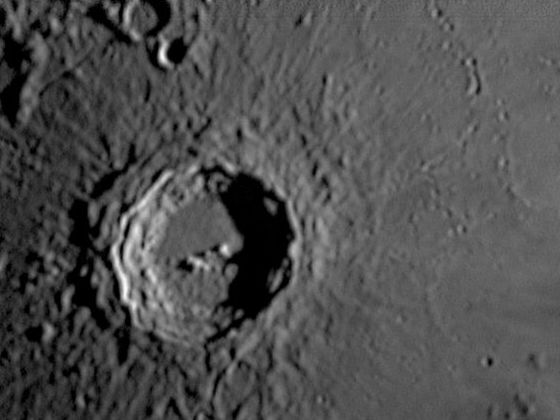
|
This is a closer picture taken at about the same lunation but taken with a ToUcam attached to my ETX125 with a X2 lens attached on 30th March 2004, when the Moon was 9.1 days old.
Date and Time: 30th March 2004 20:58 UT Camera: ToUcam 740K Telescope: ETX125 with X2 lens Capture: K3CCDTools. 50% gamma, 1/33", 15% gain, 364 frames Processing: Registax. 214 frames stacked. Wavelet 1,2 = 10, wavelet 3 =5 |
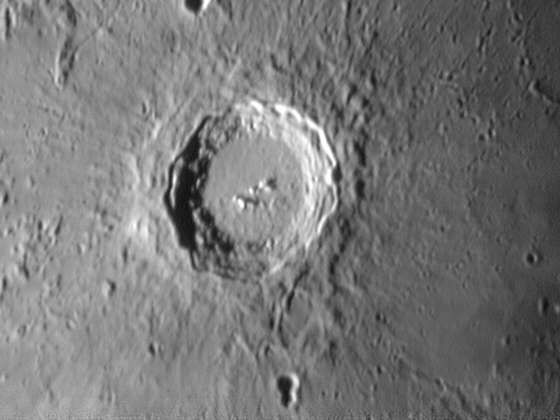
|
This picture was taken with a ToUcam attached to my LX200 with a X2 lens attached on 7th October 2004, when the Moon was 22.8 days old. The Sun was only about 10° above the western horizon so it was late afternoon there. Even so there are few shadows because Copernicus is relatively shallow - less than 4 Km deep but 95 Km is diameter. However the western slopes must be steeper than 10°. The arrows in the bottom left-hand corner represent approximately 50 Km north and east. Date and Time: 7th October 2004 03:56 UT Camera: ToUcam 740K Telescope: LX200 with X2 lens Capture: K3CCDTools. High gamma, 1/50", 36% gain, 392 frames Processing: Registax. 254 frames stacked. Wavelet 1-3 = 10 Click here to see a mosaic of this area taken at the same time. |
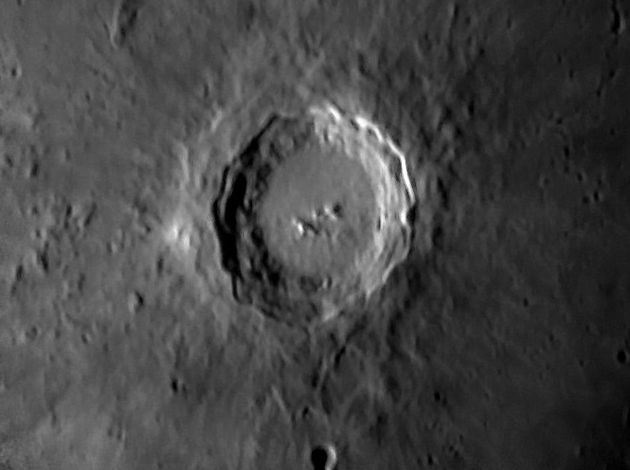
|
This picture is very similar to the one above and is taken at the same phase (22.9 days). It differs in two technical ways. Firstly it is taken with a low gamma on the camera, which makes it somewhat darker, and secondly it has been sharpened with Focus Magic rather than RegiStax wavelets. The larger scale results from the fact that the Moon was 27,600 Km (7%) closer to me when I took this picture compared to that above. I've not provided a mouseover for this image; apart perhaps from scale markers there is nothing to add to the mouseover above. The picture was taken on 22nd October 2008 when the Moon was 22.9 days old. Date and Time: 22nd October 2008 05:53 UT Camera: ToUcam 740K with Neodymium filter Telescope: LX200 with X2 lens Capture: K3CCDTools. Low gamma, 1/33", 59% gain, 643 frames Processing: Registax. 282 frames stacked. Histogram 0-140 Wavelet 2 = 5 Focus Magic 5,100 |
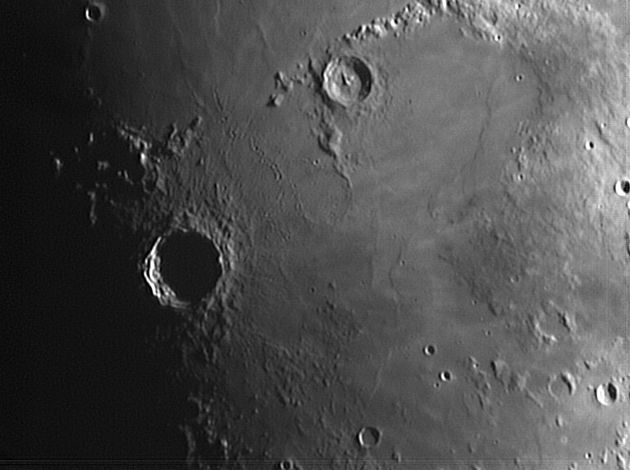
|
This is a wider picture taken with a ToUcam attached to my ETX125 on 15th July 2005,
when the Moon was 8.5 days old. It shows Copernicus in the lower left and
Eratosthenes towards the top and the very
southern end of the Apennine mountains at the very top. The picture was taken 50
minutes before sunset and was made in infra-red light. The Sun was only just rising over Copernicus whose floor is still in darkness, but Eratosthenes is almost 9° east of Copernicus, so the Sun was 9° higher in the sky, and it is somewhat less deep than Copernicus and so its floor is almost fully illuminated. Date and Time: 15th July 2005 19:26 UT Camera: ToUcam 740K Telescope: ETX125 Capture: K3CCDTools. 0% gamma, 1/25", 23% gain, 398 frames Processing: Registax. 178 frames stacked. Wavelet 1-3 = 10, contrast 240, brightness -50 |
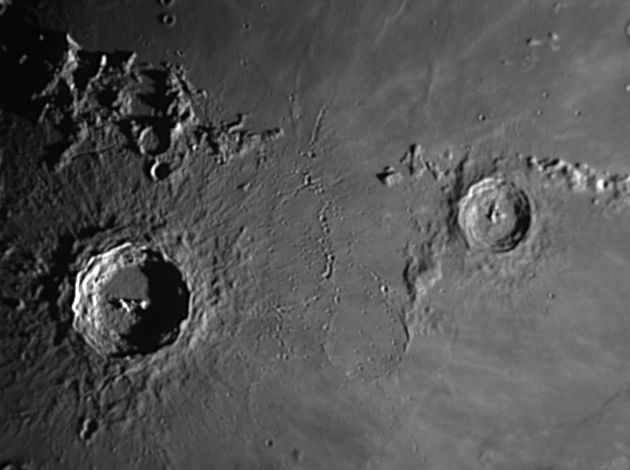
|
A wider picture showing Copernicus with nearby Eritosthenes. This picture one of a set of 5 that form a mosaic from Copernicus along the Apennines to the Caucasus mountains, which may be seen here. The scale markers are approximately 100 Km north and west. Date and Time: 27th December 2017 19:01 UT Camera: DMK 21AF04 Telescope: LX200 Capture: ICCapture. 1/367", gain 741, 1792 frames Processing: Registax6. 26 alignment points, 100 frames stacked per point. Wavelet 1-2 = 5, gamma 1.4 |
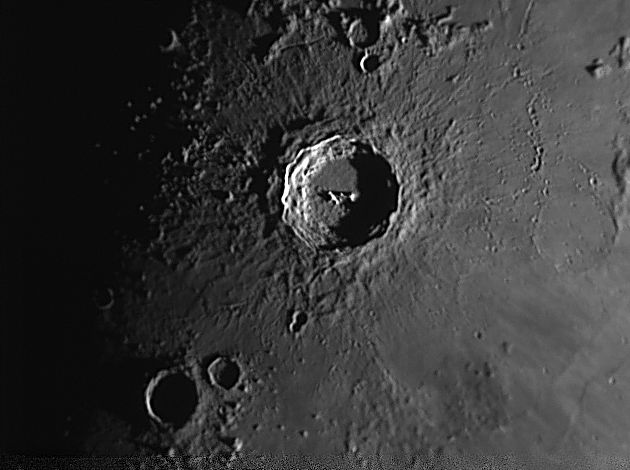
|
This picture completes a set of 5 to form a mosaic north from here along the Apennines which may be seen here. The scale markers are approximately 100 Km north and west. The picture was taken with a DMK camera fitted to my LX200 on 27th December 2018 when the Moon was 8.8 days old. Lunar Phase: 72.3° Colongitude: 24.7° Libration: +6° 56' in latitude, -7° 49' in longitude Date and Time: 27th December 2017 19:07 UT Camera: DMK 21AF04 Telescope: LX200-10 with ADC* Capture: ICCapture. 1/367", gain 741, 1800 frames Processing: Registax6. 16 alignment points, 100 frames stacked per point. Wavelet 1-2 = 5, gamma 1.3 *ADC = Atmospheric Dispersion Corrector |
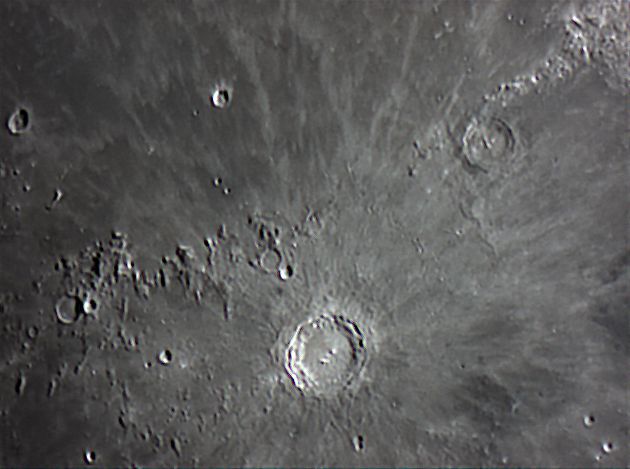
|
This is a slightly wider-angle picture taken with my ETX125 which has a shorter focal length (1900 mm) than my LX200 (2400 mm). Although the Sun was not particularly high in the lunar sky (~30°) at the time, the rays from Copernicus show up very nicely. An interesting feature of this picture is that it includes the two craters that give their names to the most recent two eras in lunar history. The Copernican age runs from 1,100 million years ago until the present time, and the Eratosthenian age runs from 3,200 to 1,100 million years ago. The scale markers are approximately 100 Km north and west. Lunar Phase: 50.1° Colongitude: 45.8° Libration: -5° 7' in latitude, -5° 38' in longitude Date and Time: 22nd May 2021 22:25 UT Camera: DFK 21AF04 Telescope: ETX125 Capture: ICCapture. 1/120", gain 795, 1648 frames Processing: Registax5. 600 frames stacked. Wavelet 1-2 = 10 Focus Magic 4 |
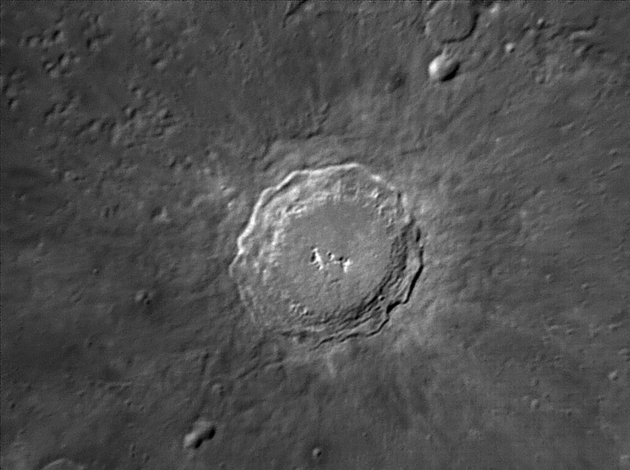
|
This picture is the result of a combination of luck and a new technique. The luck was that seeing was good enough to warrant the use of a ×2 Barlow attached to my LX200. The new technique is to use the drizzling function in Registax. This technique produces a 2-fold magnified image whilst retaining the resolution. I processed the image in this form but had to reduce it by a factor of 2 to fit this page. Click on the image to see the full-sized version which opens in a new window. I have not made a mouseover for this picture but North is about 30° clockwise of straight up (Gay-Lussac A, see mouseover of image above, is due north of the centre of Copernicus). The elevation of the Sun would have been about 30° above the Eastern horizon and yet the eastern wall is not casting a shadow onto the floor of the crater. However you can see that the highest ridge of the crater is casting a small shadow and the similar place in the west is brightly lit by the Sun.
Lunar Phase: 37.1° Colongitude: 49.4° Libration: 2° 25' in latitude, 3° 41' in longitude Date and Time: 15th December 2021 18:07 UT Camera: DFK 21AF04 Telescope: LX200 with ×2 tele-adaptor lens and infra-red pass filter Capture: ICCapture. 1/154", gain 944, 3373 frames Processing: Registax5. 3373 frames stacked with drizzle factor 0.5. Wavelet 1-3 = 30 Focus Magic 4 |
Home Back to NW Quadrant Page 2